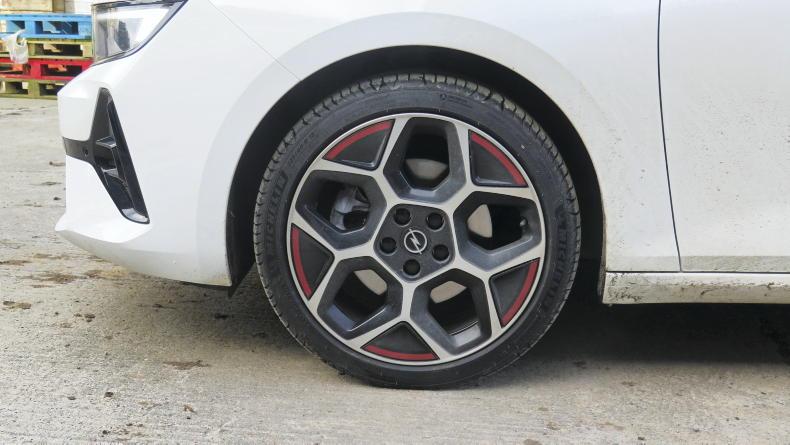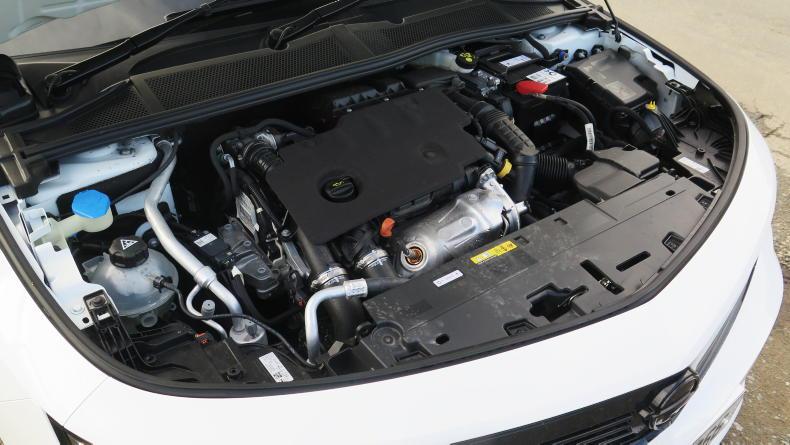The new Opel Astra Sports Tourer brings a welcome return to economical and open-range driving. Part of the reason why that was clear after the first day of my driving experience, was the economical turbo-diesel engine under the bonnet.
The motor industry is moving rapidly towards battery electric cars, and they have huge merits in the right circumstances. The issues remain of range and increasingly depreciation costs, while the buy-in prices for battery electric cars are still high. That all combines to make the move to battery electric cars a very big decision.

The tested Opel Astra Sports Tourer came on Michelin low-profile Primacy 235/40 R18 tyres that delivered low noise levels, but the low-profile design and suspension meant some issues with ground clearance on smaller rural roads.
It was interesting to note that Stellantis Group CEO Carlos Taveres recently said at the first Freedom of Mobility Forum, that electrification will not be the panacea for clean mobility that some people believe.
“What is also obvious is the solutions we are trying to bring as an industry, such as electrification, are not going to be solving all of the problems. Urban areas and rural areas may, eventually, need different solutions,” he added.
Drive the new Opel Astra Sports Tourer, as I did recently, and you’ll not be convinced that the diesel engine is on the point of being extinct. This Opel proves that very well and the Opel brand is also part of the Stellantis Group. Accepting that emissions remain an issue for internal combustion engines and in that sense, they are no match for battery electric cars, when you have a choice where a full tank of diesel coupled with modern low emission diesel engines, can deliver a range of over 1,000 kilometres, then it’s just too early to demonise diesel car and van drivers.
Park the fuel issue aside and the new Opel Astra Sports Tourer will tick lots of boxes for rural drivers.
The car is modern in terms of styling, comfort and space, while blending some practical features with the sensible use of technology. The only potential downside is the low ground clearance.
The engine choice for the Astra Sports Tourer was a 1.5-litre turbo-diesel unit that’s very fuel-efficient. Cruising on the motorway allowed me to drive at the 120km/hr limit at under 2,000 engine rpm. That, coupled with a smooth eight-speed automatic gearbox, allowed that experience to be pleasurable as well as economical.

The upgraded 1.5-litre turbo-diesel engine for the Opel Astra Sports Tourer is powerful with good towing ability at 1.4 tonnes.
My test returned an economy figure of 4.9l/100km (20km/litre), which was about 10% lower than the rated figure. I’m getting very comfortable with cruise control and keeping the speed at around 100km/hr on main roads, and this is clearly delivering impressive economy.
I can live with all that when I get over 1,000km from a full 52-litre capacity fuel tank.
I’ve compared this new Astra estate with Ford’s Focus estate offering and there is little to separate them in terms of economy and engine performance.
The Ford option has a slightly smaller capacity fuel tank, is almost the same weight and length, but has marginally bigger boot space when five seat places are in use.
The Opel Astra has more style and I found it easier to set up the mobile phone. Even changing the car’s clock was easier than many others where you would almost have to be able to write space shuttle software to make a simple summertime clock change.
The dash layout is clear, easy to use and features buttons, as well as a digital display. Heating controls are clear and easy. These are the practical aspect of driving the Opel Astra. The button features mean less distracted driving and it’s easier to remain focused on the road ahead.

The interior layout and dash on the Opel Astra Sports Tourer is clear, modern, and functional and there’s a space saver spare wheel in the boot.
The entry price for the Opel Astra Sports Tourer is €37,995 or £26,605 in Northern Ireland, which is comparable with Ford’s pricing for the Focus, with a similar size turbo-diesel engine.
What’s interesting is the extent of new car price increases, which for the Astra Sports Tourer reflects a 19% increase since 2022. That’s the bit that’s difficult to justify and it’s also the feature that impacts most on running costs. I’ve looked at the few 2022 Astra Sports Tourers for sale this week and depreciation levels are running at 37% over three years – 12% per year.
That is the biggest cost in car ownership (64% in the case of the Astra Sports Tourer) and gives an ownership cost of about €0.36/km, which is competitive and lower than many mid-size SUVs with significantly less boot space.
Safety package
The car comes with an impressive safety package, but unfortunately that was not enough to deliver a five-star Euro NCAP safety rating. There are two rear Iso-fix points and ADAS camera systems for clear warning points with the front camera tucked in neatly to the Opel Vizor front grille design.
In summary, the Opel Astra Sports Tourer delivers in terms of economy and style with lots of clear and easy-to-use functions. It has got expensive, but remains competitive with Ford’s offering, while my preference is for the Opel styling.
Opel Astra Sports Tourer 1.5 Turbo D Engine: 1.5-litre turbo diesel. Engine and electric power: 130bhp. Engine torque: 205Nm.0-100km/hr: 10.6 seconds.Economy: 4.5l/100km or 22.2km/litre.CO2 rating: 133g/km.Road tax annual: B1 €200.Main service: 12 months or 30,000km.Euro NCAP rating: four-star (2022).Fuel tank capacity: 52 litres.Luggage capacity: 597/1,634 litres.Towing capacity: 1,500kg.Warranty: three years or 100,000km.Entry price: €37,995 or £26,605 in NI.
The new Opel Astra Sports Tourer brings a welcome return to economical and open-range driving. Part of the reason why that was clear after the first day of my driving experience, was the economical turbo-diesel engine under the bonnet.
The motor industry is moving rapidly towards battery electric cars, and they have huge merits in the right circumstances. The issues remain of range and increasingly depreciation costs, while the buy-in prices for battery electric cars are still high. That all combines to make the move to battery electric cars a very big decision.

The tested Opel Astra Sports Tourer came on Michelin low-profile Primacy 235/40 R18 tyres that delivered low noise levels, but the low-profile design and suspension meant some issues with ground clearance on smaller rural roads.
It was interesting to note that Stellantis Group CEO Carlos Taveres recently said at the first Freedom of Mobility Forum, that electrification will not be the panacea for clean mobility that some people believe.
“What is also obvious is the solutions we are trying to bring as an industry, such as electrification, are not going to be solving all of the problems. Urban areas and rural areas may, eventually, need different solutions,” he added.
Drive the new Opel Astra Sports Tourer, as I did recently, and you’ll not be convinced that the diesel engine is on the point of being extinct. This Opel proves that very well and the Opel brand is also part of the Stellantis Group. Accepting that emissions remain an issue for internal combustion engines and in that sense, they are no match for battery electric cars, when you have a choice where a full tank of diesel coupled with modern low emission diesel engines, can deliver a range of over 1,000 kilometres, then it’s just too early to demonise diesel car and van drivers.
Park the fuel issue aside and the new Opel Astra Sports Tourer will tick lots of boxes for rural drivers.
The car is modern in terms of styling, comfort and space, while blending some practical features with the sensible use of technology. The only potential downside is the low ground clearance.
The engine choice for the Astra Sports Tourer was a 1.5-litre turbo-diesel unit that’s very fuel-efficient. Cruising on the motorway allowed me to drive at the 120km/hr limit at under 2,000 engine rpm. That, coupled with a smooth eight-speed automatic gearbox, allowed that experience to be pleasurable as well as economical.

The upgraded 1.5-litre turbo-diesel engine for the Opel Astra Sports Tourer is powerful with good towing ability at 1.4 tonnes.
My test returned an economy figure of 4.9l/100km (20km/litre), which was about 10% lower than the rated figure. I’m getting very comfortable with cruise control and keeping the speed at around 100km/hr on main roads, and this is clearly delivering impressive economy.
I can live with all that when I get over 1,000km from a full 52-litre capacity fuel tank.
I’ve compared this new Astra estate with Ford’s Focus estate offering and there is little to separate them in terms of economy and engine performance.
The Ford option has a slightly smaller capacity fuel tank, is almost the same weight and length, but has marginally bigger boot space when five seat places are in use.
The Opel Astra has more style and I found it easier to set up the mobile phone. Even changing the car’s clock was easier than many others where you would almost have to be able to write space shuttle software to make a simple summertime clock change.
The dash layout is clear, easy to use and features buttons, as well as a digital display. Heating controls are clear and easy. These are the practical aspect of driving the Opel Astra. The button features mean less distracted driving and it’s easier to remain focused on the road ahead.

The interior layout and dash on the Opel Astra Sports Tourer is clear, modern, and functional and there’s a space saver spare wheel in the boot.
The entry price for the Opel Astra Sports Tourer is €37,995 or £26,605 in Northern Ireland, which is comparable with Ford’s pricing for the Focus, with a similar size turbo-diesel engine.
What’s interesting is the extent of new car price increases, which for the Astra Sports Tourer reflects a 19% increase since 2022. That’s the bit that’s difficult to justify and it’s also the feature that impacts most on running costs. I’ve looked at the few 2022 Astra Sports Tourers for sale this week and depreciation levels are running at 37% over three years – 12% per year.
That is the biggest cost in car ownership (64% in the case of the Astra Sports Tourer) and gives an ownership cost of about €0.36/km, which is competitive and lower than many mid-size SUVs with significantly less boot space.
Safety package
The car comes with an impressive safety package, but unfortunately that was not enough to deliver a five-star Euro NCAP safety rating. There are two rear Iso-fix points and ADAS camera systems for clear warning points with the front camera tucked in neatly to the Opel Vizor front grille design.
In summary, the Opel Astra Sports Tourer delivers in terms of economy and style with lots of clear and easy-to-use functions. It has got expensive, but remains competitive with Ford’s offering, while my preference is for the Opel styling.
Opel Astra Sports Tourer 1.5 Turbo D Engine: 1.5-litre turbo diesel. Engine and electric power: 130bhp. Engine torque: 205Nm.0-100km/hr: 10.6 seconds.Economy: 4.5l/100km or 22.2km/litre.CO2 rating: 133g/km.Road tax annual: B1 €200.Main service: 12 months or 30,000km.Euro NCAP rating: four-star (2022).Fuel tank capacity: 52 litres.Luggage capacity: 597/1,634 litres.Towing capacity: 1,500kg.Warranty: three years or 100,000km.Entry price: €37,995 or £26,605 in NI. 








 This is a subscriber-only article
This is a subscriber-only article











SHARING OPTIONS: